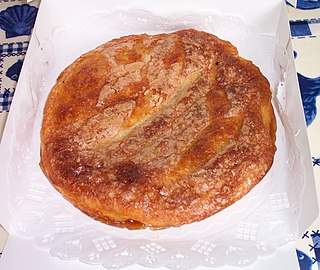
Puff pastry, also known as pâte feuilletée, is a flaky light pastry made from a laminated dough composed of dough and butter or other solid fat. The butter is put inside the dough, making a paton that is repeatedly folded and rolled out before baking.

Pastry is baked food made with a dough of flour, water and shortening that may be savoury or sweetened. Sweetened pastries are often described as bakers' confectionery. The word "pastries" suggests many kinds of baked products made from ingredients such as flour, sugar, milk, butter, shortening, baking powder, and eggs. Small tarts and other sweet baked products are called pastries as a synecdoche. Common pastry dishes include pies, tarts, quiches, croissants, and pasties.

A croissant is a buttery, flaky, viennoiserie pastry inspired by the shape of the Austrian kipferl but using the French yeast-leavened laminated dough. Croissants are named for their historical crescent shape. The dough is layered with butter, rolled and folded several times in succession, then rolled into a thin sheet, in a technique called laminating. The process results in a layered, flaky texture, similar to a puff pastry.

A Danish pastry is a multilayered, laminated sweet pastry in the viennoiserie tradition. The concept was brought to Denmark by Austrian bakers, where the recipe was partly changed and accommodated by the Danes to their liking, and has since developed into a Danish specialty. Like other viennoiserie pastries, such as croissants, it is a variant of puff pastry made of laminated yeast-leavened dough that creates a layered texture.

Dough is a thick, malleable, sometimes elastic paste made from grains or from leguminous or chestnut crops. Dough is typically made by mixing flour with a small amount of water or other liquid and sometimes includes yeast or other leavening agents, as well as ingredients such as fats or flavorings.

Kouign-amann is a sweet Breton cake made with laminated dough. It is a round multi-layered cake, originally made with bread dough, containing layers of butter and incorporated sugar, similar in fashion to puff pastry albeit with fewer layers. The cake is slowly baked until the sugar caramelizes and the butter expands the dough, resulting in its layered structure. A smaller version, kouignette, is similar to a muffin-shaped, caramelized croissant.

Filo or phyllo is a very thin unleavened dough used for making pastries such as baklava and börek in Middle Eastern and Balkan cuisines. Filo-based pastries are made by layering many sheets of filo brushed with oil or butter; the pastry is then baked.

Pain au chocolat, also known as chocolatine in the south-west part of France and in Canada, or couque au chocolat in Belgium, is a type of Viennoiserie pastry consisting of a cuboid-shaped piece of yeast-leavened laminated dough, similar in texture to a puff pastry, with one or two pieces of dark chocolate in the center. The chocolate usually has a slight bite to the texture.

Bourekas or burekas are a popular baked pastry in Sephardic Jewish cuisine and Israeli cuisine. A variation of the burek, a popular pastry throughout southern Europe, northern Africa and the Middle East, Israeli bourekas are made in a wide variety of shapes and a vast selection of fillings, and are typically made with either puff pastry, filo dough, or brik pastry, depending on the origin of the baker.

Viennoiseries are French baked goods made from a yeast-leavened dough in a manner similar to bread, or from puff pastry, but with added ingredients, which give them a richer, sweeter character that approaches that of pastry. The dough is often laminated.

Flaky pastry, also known as quick pastry, blitz pastry or rough puff, is a light and thin unleavened pastry that is similar to, but distinct from, puff pastry. It is often called quick pastry or blitz pastry in reference to the short time its preparation requires.
Dough sheeting technology is used by (industrial) bakeries and rolls out dough into a (consistent) dough sheet with a desired even dough thickness.

A torpedo dessert is a buttery, flaky viennoiserie bread roll, filled with pastry cream, named for its well-known torpedo shape. Croissants and other viennoiserie are made of a layered yeast-leavened dough. The dough is layered with butter, rolled and folded several times in succession, then rolled into a sheet, in a technique called laminating. The process results in a layered, flaky texture, similar to a puff pastry.

Paratha is a flatbread native to South Asia, with earliest reference mentioned in early medieval Sanskrit text from Karnataka, India; prevalent throughout the modern-day nations of India, Sri Lanka, Pakistan, Nepal, Bangladesh, Maldives, Afghanistan, Myanmar, Malaysia, Singapore, Thailand, Mauritius, Fiji, Guyana, Suriname, and Trinidad and Tobago where wheat is the traditional staple. Paratha is an amalgamation of the words parat and atta, which literally means layers of cooked dough. Alternative spellings and names include parantha, parauntha, prontha, parontay, paronthi (Punjabi), porota, paratha, porotta, palata, porotha, forota, farata, prata, paratha, buss-up shut, oil roti and Roti Canai in Malaysia.

Malawach or Melawwaḥ,, is a flatbread that is traditional in Yemenite Jewish cuisine. It was brought to Israel by Yemenite Jews. Malawach resembles a thick pancake but consists of thin layers of puff pastry brushed with oil or fat and cooked flat in a frying pan. It is traditionally served with hard-boiled eggs, zhug, and a crushed or grated tomato dip. Sometimes it is served with honey.

Chinese flaky pastry is a form of unleavened flaky pastry used in traditional Chinese pastries that are invariably called subing. There are two primary forms, Huaiyang-style (淮揚酥皮) and Cantonese-style pastry (廣式酥皮). Huaiyang-style pastry is used to make delicacies such as Shanghainese 'crab shell' pastries (蟹殼黃) while Cantonese-style pastry is used to make pastries like sweetheart cakes.














